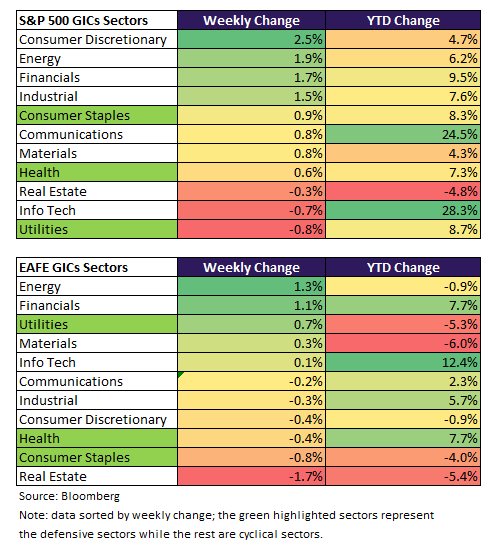Weekly Good Reads: 5-1-1
Economy in Unstable Equilibrium, Maniac Territory, Displacing Banking Jobs, "Values" Investing, Direct Indexing
Welcome to Weekly Good Reads 5-1-1 by Marianne, a 25-year investment practitioner writing about investing, economy, wellness, and something new I learned in AI/productivity.
Each week I share insightful/essential readings, charts, and one term, incorporating some of my market observations. You can find the weekly changes of the major indices or indicators in the Weekly Change charts. But I look beyond data and share something enlightening about life, health, technology, and the world around us 🌍!
Here’s the quote of the week:
If you look for perfection, you'll never be content. ~ Leo Tolstoy
I archived my Weeklies here and the index of charts and terms here. Check out my conversations with Female Investors and more, which I hope will inspire more females into finance and investment careers 🙌. Easily subscribe to my newsletter by clicking below.
Feedback is important to me, so if you like the Weekly, please “heart” it, comment or share it with your contacts. Thank you so much for your support🙏.
Market and Data Comments
Global stock markets and bonds were relatively unexciting this week with the tech sector in the US stalling, as the Nasdaq was practically unchanged.
A recent Bank of America fund managers survey revealed the state of the US stock market: money market funds assets/cash (at $6.1 tn) is at an all-time low since November 2021—“41% of global fund managers expect large-cap growth stocks to continue to drive the US rally. Big tech has contributed nearly three-quarters of the S&P 500’s rally this year, with Nvidia alone driving 34% of the gains, according to data compiled by Bloomberg.”
At the same time, Citibank pointed out that economic data has disappointed despite the S&P 500 rise (see top chart).
Nvidia’s continued stock price rise heavily depends on the spending/capex/earnings of its big-tech and communications customers including Microsoft, Google, and Meta. All is well when the US economy is strong. But when the economy decidedly slows (evidenced by the US consumers restraining spending as retail sales rose just +0.1% in May and -0.2% in April), the Fed holding rates for longer, and the cash level at a 3-year low, a hick-up in NVDA could bring down the entire stock market (See Econ/Invest. #1).
So far most of the big tech have revenue and earnings support for their valuation, but diversification is key to investing especially at this stage.
The Bank of England did not cut interest rates in its recent Monetary Policy meeting, but its balanced tone and shift of concerns away from services inflation opened up the chance of an August cut. Japan saw May inflation rising to 2.8% y/y (2.5% prior), pointing to an interest rate hike. China has had mixed data—stronger May retail sales but weaker-than-expected industrial production (+5.6% y/y) and fixed asset investments (+3.5% y/y with property investments -11% y/y)
It is worth pointing out in the recent Apollo mid-year 2024 economic outlook: an unstable economic equilibrium, Torsten Stok expected more upside risk to US economic growth than downside risk because the easier financial conditions (ever since the Fed pivoted, i.e. turned dovish, in October 2023) have been helpful to corporate financing and investment plans and have counteracted the negative effect from rising interest rates.
Business confidence has been rebounding and recession risk from consensus has been declining. Consensus is expecting growth to expand so underlying consumer strength may be under-estimated. As a result, US economic growth could end up higher than the consensus expectations and the Fed has to hold interest rates longer because inflation is not coming down to the Fed’s 2% target fast enough.
The below graph shows Fed Funds futures expect the Fed Funds to bottom at 4% (darker green dotted line), indicating “higher for longer”. The key takeaways from Apollo’s presentation are summarized below.
This coming week, we will monitor the World Economic Forum held in Dalian City, China from Tuesday to Thursday, the first US presidential debate on Thursday, and the US core PCE index and personal income data on Friday.
Economy and Investments (Links):
We Have Entered Mania Territory with Nvidia (Bloomberg or via Archive)
+ (Related) Nvidia Has Boosted the S&P 500. Now It Could Tank It (Barron’s or via Archive).
US Borrowing Binge Risks Market Strains, Analysts Warn (FT or via Archive)
Citi Sees AI Displacing More Bank Jobs Than Any Other Sector (Bloomberg or via Archive)
Finance/Wealth (Link):
Can Your Investment Portfolio Reflect Your Values? (New York Times)
You can do your own subtraction inside an index-like collection of investments through a strategy called direct indexing. It’s available mostly in brokerage accounts and not retirement ones, though that may change as the strategy becomes more popular.
Learn more in One Term to Know (below): Direct Indexing
Wellness/Idea (Link)
Election Anxiety Is Real, So Make a Plan to Disengage (A Year of Mental Health by
)One Chart You Should Not Miss: GDPNow
GDPNow is produced by the Atlanta Federal Reserve but is not its official forecast.
The forecasting model provides a “nowcast” (modelled after the weather nowcast albeit over a longer period.) GDPNow is strictly based on a mathematical model and is a running estimate of real GDP growth using available economic data for the current measured quarter, with the methodology based on the Bureau of Economic Analysis.
As of June 21, 2024, GDPNow is 3.0% for Q2 2024.
The top chart below shows the subcomponent contributions to GDPNow while the solid line denotes the evolution of GDPNow. The bottom chart shows the evolving subcomponent contributions to GDPNow.

You can download the EconomyNow App which includes GDPNow and the Wage Growth Tracker to track the latest data on inflation, growth, and the labor market.
Who would have guessed that sharing an economic chart can be so cool and easy?

One Term to Know: Direct Indexing
Direct indexing is a tax-efficient index-replicating strategy (copying an index’s appropriate component stock weights) while allowing individual customization.
The strategy involves buying all the stocks e.g. 500 of them in the S&P 500, which is different from owning a fund that tracks the performance of the S&P 500 index (ETF or index fund). This usually takes place in a separately-managed account as many stock transactions are involved.
Tax efficiency arises as stocks that incur capital losses are sold (i.e. tax-loss harvesting) to offset the capital gains from the other positions, thus lowering the investor’s tax bill. More and more financial firms offer automated solutions to harvest tax losses all year around, helped by zero-cost commissions.
The drawbacks of direct indexing include a higher management fee due to the volume of transactions, a higher minimum investing amount, and tracking error (returns do not entirely match the S&P 500 index because of the level of customization).
[🌻] Things I Learn About AI/Productivity:
Presentation: Generating a presentation (and documents and website) using AI prompts is never easier with the Gamma app:
Prompt: Create a presentation to explain Green Tea Living related to beauty, cuisine, cleaning, health, recycling, and reuse.
After fact-checking and a few quick tweaks, here’s the video slide. What do you think 👋?
In my view, the slides appear more fitting and intelligent and contain various formats compared with those created from Canva (free version).
The free version gives you 400 credits, and you can generate PDFs and PowerPoints.
Newsletter on AI: I have been reading the Superhuman AI newsletter by Zain Kahn, now with 700,000+ subscribers for updated AI and productivity tools and news. He said this is how he used Gen AI for his newsletter.
I write the newsletter content myself, and I delegate the research to my staff. Our newsletter is all about AI, so we feature AI-generated images in every issue as well as an AI-created AI tutorial.
We most frequently use ChatGPT, mainly for ideation, such as coming up with email subject lines or different angles for a story, and for proofreading. We also use ChatGPT plugins to do tasks including summarizing or simplifying research papers. This saves us about five to 10 hours every week.
Are you using GenAI in your newsletter? I find researching terms using GenAI helpful, but financial writers must be accurate with data and events so traditional financial news sources and your own experiences still win.
Please do not hesitate to get in touch if you have any questions!
Please also check out my Conversations with female fund managers, wealth advisors, and more!
Also, if you miss my latest post about investing, please read it here:
If you like this Weekly, please share it with your friends or subscribe to my newsletter🤝.











Nice post. It's amazing how we assumed the FED already pivoted 7 months ago but they haven't cut rates once yet haha. Just imagine what markets will look like once they do! Assuming no recession of course.
Many analysts (including at the Fed) keep talking about a latency effect of Fed policies (rate hikes still working their way through the economy), but I would agree that the economy has already adjusted to higher rates (which aren’t that high in even medium-term perspective).